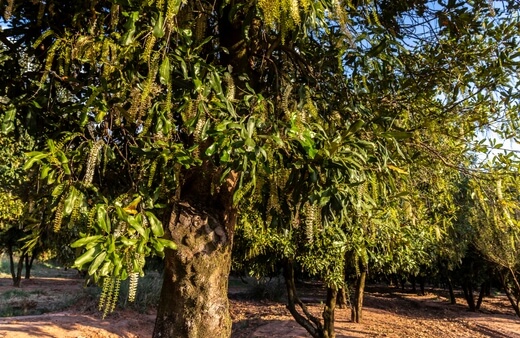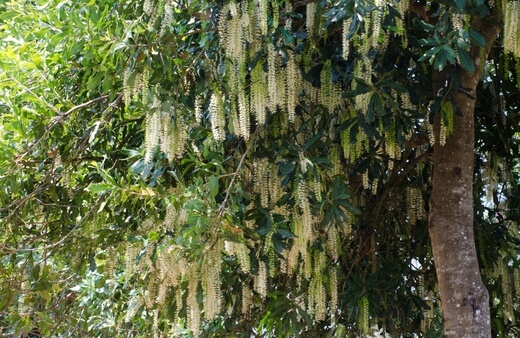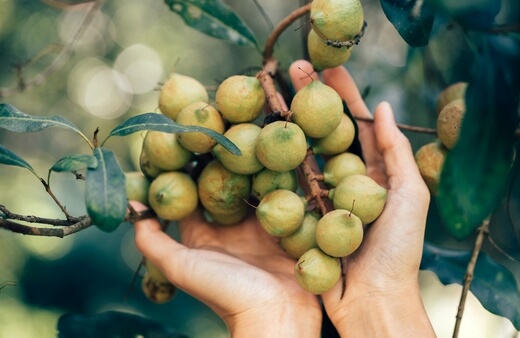If you can grow nuts and seeds as a crop at home, why wouldn’t you? is one of the healthiest sources of protein and fats on the planet and is native right here in Australia.
Like most trees, the hard work with macadamia is in the first three to five years in your garden, regardless of its size and age. Until macadamia roots have properly established, they are susceptible to winter rot and can be killed by frost in loose ground.
Follow our guide to keep your young trees happy, and learn how to care for mature macadamia trees all year round.
More...

Family: | Proteaceae |
|---|---|
Genus: | Macadamia |
Species: | M. integrifolia, M. jansenii, M. ternifolia, and M. tetraphylla |
Common Names: | Macadamia nut, Macadamia |
Location: | Outdoor |
Type: | Evergreen Tree |
Growth: | 6-18m tall |
Sun requirements: | Full sun |
Foliage Colour: | Green |
Flower Colour: | White or pink |
Flowering: | Spring |
Fruit: | Edible nuts (ripening is seasonal, but changes based on location) |
Maintenance level: | Low |
Poisonous for pets: | Toxic to cats and dogs (nausea, vomiting, muscle weakness) |
What is a Macadamia Tree?
Macadamia trees are beautiful evergreens, with tough, green, satiny leaves. Each species has slightly different habits, with foliage ranging from long blades with spiky perforations to shorter round leaves with smooth borders.
In terms of colouring, macadamia foliage is a rich green colour, ranging from deep emerald green to a tone similar to mature ivy leaves. Its nuts are encased in a tough green flesh and harvested by removing the flesh once dry.
Bush Nut's Natural Habitat
Macadamia is native to Australia and can be found growing wild from New South Wales through to Queensland. Today, they are harvested commercially in most warm tropical climates and are still grown commercially in Hawaii, where the first plantation was started in the 1880s.
South Africa is the world’s largest commercial grower of macadamia trees, but every single species is still at its happiest right here on our shores. While macadamia prefers the warmer parts of Queensland, it will grow happily in almost all parts of the country and is hardy down to about -5°C once established.
Young trees will need to be protected with fleece in southern Australia and Tasmania though.
Macadamia Tree Species
There are only four species of macadamia trees, and other than a few specific cultivars, all retain the key identifiers of the naturally bred spices; Macadamia integrifolia, Macadamia jansenii, Macadamia ternifolia, and Macadamia tetraphylla.

Macadamia integrifolia
Commonly called the bush nut, Queensland nut, or smooth-shelled macadamia, they are gorgeous trees and much underrated for ornamental use. They will not survive winters below freezing even when mature.
The most widely cultivated macadamia, particularly in South and Central America is Macadamia integrifolia, with some trees reaching up to 15m tall. Its twisting branches carry heavy nuts, and have wide, spoon-shaped leaves.
Macadamia jansenii
Less useful in cultivation is Macadamia jansenii, whose nuts, leaves, and stems are considered to be toxic. If you can get hold of one from a responsible source, they make excellent garden trees at just 9m tall after 10-15 years, but you’ll need to be clear with any visitors that the seeds are strictly not for eating!
Macadamia ternifolia
Often called the small-fruited Queensland nut, or the Gympie nut, Macadamia ternifolia grows to just 8m tall, making it the smallest cultivar you can grow at home, and with entirely edible seeds.
Its foliage is perhaps the most easily recognisable too, with serrations on the leaf borders, and wonderfully structured droops of fluffy flowers in spring.


Get Your Free Guide:
Master Growing Australian Natives eBook
A Must Have Complete Guide for Every Australian Garden
Get Your Free Guide:
Master Growing Australian Natives eBook
A Must Have Complete Guide for Every Australian Garden
Macadamia tetraphylla
The bauple nut, prickly macadamia, or rough-shelled bush nut are all names given to Macadamia tetraphylla. At 18 metres tall, it is the largest species of Macadamia native to Australia and produces the largest nuts.
Its dense evergreen foliage makes it an attractive alternative to deciduous ornamentals, and its dramatic pendulums of flowers provide abundant seasonal interest.
How to Grow Macadamia in Australia
Remember that Macadamias, particularly when young, are not hardy. They need tropical climates to get through winter until their roots have fully established and they have begun bearing fruit.
Until that point, it’s essential to wrap them for winter and protect them from the elements. For that reason, we would always suggest planting younger saplings in cooler parts of Australia so they can be fleeced easily over winter.

Planting Macadamia Trees
Nearly all aspects of planting have to be spot on to grow a macadamia nut tree happily in any part of the world. They need slightly acidic soil (slightly more than average: pH of 5.5 is ideal) and need a really clear root run, in loose soil.
So, regardless of the soil, water, and light you provide, preparing the plot is the first big step.
Start by digging out at least 1m deep of soil to provide easy access to the vertical tap root, which plunges down into the soil to anchor the tree in place. The faster the tap root can establish, the more likely your tree is to survive a cold winter!
Soil & Drainage
Soil should be well-drained, and with a pH of 5-6.5. They need a fair amount of water, but should never be left standing in damp soil. For the first two years, ensure the soil never dries out completely by watering once a week, or once a fortnight in cooler areas, and mulching generously with organic compost in spring to lock in moisture over summer.
Light & Temperature
Macadamia trees need full sun. There are some situations where that’s impossible, like planting dwarf varieties in the shade of a house, but they should at least have access to bright, reflective spaces where they are kept warm through summer, and ideally above 10°C in winter.
How to Propagate Macadamia Trees

Propagating Macadamia Trees from Seed
To grow macadamia trees from their seeds, you’ll need to soak the seeds. Don’t use store-bought seeds, as they can be treated with all sorts of preservative chemicals which will stop them from sprouting in humid or bright environments.
- Soak seeds for 24 hours
- Push the seeds 2cm deep into well-drained soil.
- Cover with compost, or water until the hole fills in on itself.
- Germination can take 4-5 weeks, so cover the pot with a plastic bag to maintain humidity.
- After germination, keep the soil moist, but not damp.
- When your seedling reaches 10-15cm tall, check for roots at the base of the pot. If they are showing, pot the young tree into a slightly larger pot, keep it outside, and water once a week until it’s large enough to plant out.
Caring for Macadamia Nut Trees
Macadamias are really quite needy in their first few years, whether that’s from seed, cuttings, or when planted from their sapling stage. After that, when they are clearly growing happily (usually five years after planting) they need next to no care or attention and can be left to their own devices.

Best Fertiliser to Use
If you don’t have access to garden compost or organic mulches, try using dry chicken manure pellets to fertilise your young trees. Even mature trees will benefit from a sparse application of chicken manure around the base every two or three years to boost nitrogen levels in the soil (this works for nearly all fruit and nut trees, not just macadamia).
Macadamia Bush Tucker Guide
When and How to Harvest Macadamia Nuts
Remember, the main reason to grow any fruit or nut tree is its crop. Macadamias produce fewer nuts than most similar genera, but after their fifth year (sometimes longer) they can quickly speed up their production and produce a much heavier crop than you expect.
Any time from May to September, macadamia nuts can ripen and be ready to harvest. They flower in spring, and the nuts are slow to develop, so keep an eye on the expanding fruits so you know when to take them down.
When the green flesh starts to harden, and weeps just slightly when pierced and pressed with a fingernail, it’s ready to harvest. Test one nut before harvesting them all to be sure. The nut inside should be a creamy white colour, and the outer skin inside the fleshy part of the fruit should peel away quite easily.

How to Store Macadamia Nuts
Macadamia nuts store best in their kernels. As soon as you remove them from the kernel (the fruit) they begin to spoil. Exposed nuts will go bad after about 2 weeks at room temperature, and six weeks in the fridge.
If you have already removed all the nuts from their kernels, pop them in an air-tight bag in the freezer where they’ll keep as long as they stay dry. To store macadamia nuts for as long as possible, keep them in their cases.
Macadamia nuts, in kernels, can store at room temperature in a dry, dark place, for up to five months. That can be extended to twelve months in the fridge at about 5°C, or two years in the freezer.
Macadamia Tree Frequently Asked Questions

Are macadamias easy to grow?
Macadamias are one the easiest nut trees to grow in Australia. They are native to tropical parts of the country but will grow happily even in cooler climates provided they are protected from frosts for their first four or five years.
What season do macadamias produce nuts in Australia?
Macadamia’s fruiting season differs hugely from coast to coast, but in warmer regions, they are generally ready to harvest in spring, in cooler parts of the country, macadamia nuts can be harvested any time from spring to autumn.
How many years does it take for a macadamia tree to produce nuts?
Macadamia trees generally produce nuts after about 10 years. Some species are faster to crop, but on average, your macadamia tree will need to be fully established and have reached a near-mature height before it begins to produce a significant crop.
Do macadamia trees need irrigation?
Macadamia trees need little to no irrigation to survive, but for an optimal crop, watering them sparingly once a week is crucial to a good harvest. Remember though, the more you water, the more important drainage becomes because these are trees that grow best without ever sitting in damp soil.
How long do macadamia trees live?
Macadamia trees tend to live for about 60 years, longer with clever pruning and will bear nuts after about seven years in the garden. As fruit and nut trees go, macadamia is amongst the fastest trees from seed to harvest, and longest lasting in the garden.
Can you eat macadamia nuts right off the tree?
Macadamia nuts should be cracked open and then roasted before eating for the best flavour but they are safe to eat straight from the tree. There are some suggestions online that they need preparation to be safe, but they are completely fine raw if a little bit wasteful! For best results, roast them, every time.
Looking for another Australian native fruit for roasting? Check out our Apple berry plant growing guide.
Do you need 2 macadamia trees?
It is essential to have two macadamia trees for guaranteed pollination. The more varieties you grow, the more nuts will pollinate but aim to grow two of the same variety, with some others for good measure, that way two will always be in flower at the same time, and the others will continue the pollination window.
Are macadamia nuts toxic to pets?
Macadamia nuts are incredibly toxic for dogs and will trigger vomiting, general weakness, hyperthermia, and lethargy, as well as potential ataxia (wobbling or poor coordination).
Cats are generally best kept away from nuts as nut allergies are quite common in cats.
Do macadamia trees need a lot of water?
Macadamia trees need plenty of water to produce fully ripe fruits, with tasty nuts inside. Think of the smooth texture of macadamia nuts, and all the oils they hold. That wouldn't be possible without loads of water, so keep your macadamia trees well-watered through droughts for the best harvest.
Can you grow macadamia trees in pots?
There is no tree on this green planet that cannot be grown in a pot, either to restrict its growth, or as a bonsai, but macadamias do require a lot of space to grow to full maturity and produce significant enough harvests to get excited about.
If you do grow macadamia trees in pots, pot them on every few years, or trim the roots to reinvigorate them.
Enjoy the Benefits of Growing a Macademia Tree in Your Garden
Macadamia trees might seem like a challenge, but like all native trees, there is always a way you can make them work for you. There are some keen bonsai growers who have successfully harvested full-sized macadamia nuts from bonsaied trees after fifteen years, so anything is possible.
We love growing macadamia trees here, and even in our limited space, there’s just something special about giving up part of your garden to nature and allowing large natives to thrive.
Published on December 12, 2023 by Nathan Schwartz
Last Updated on January 27, 2025




